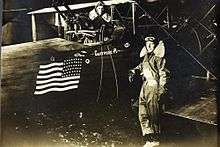Arthur Edmund Easterbrook
Lieutenant (later Brigadier General) Arthur Edmund Easterbrook started his career as a World War I flying ace credited with five aerial victories. During World War II, he held several important positions in the U. S. Army Air Corps.[1]
Arthur Edmund Easterbrook | |
|---|---|
 Easterbrook and Arthur Coyle | |
| Born | 4 November 1893 Amsterdam, New York, USA |
| Died | 24 July 1952 (aged 58) Long Beach, California, USA |
| Arlington National Cemetery | Arlington, Virginia, USA |
| Allegiance | |
| Service/ | Royal Air Force (United Kingdom) Air Service, United States Army |
| Years of service | 1917 - 1919, also during World War II |
| Rank | Brigadier general |
| Unit | Royal Air Force
Air Service, United States Army
|
| Battles/wars | World War I World War II |
| Awards | Distinguished Service Cross with Oak Leaf Cluster |
| Other work | Brigadier general during World War II |
Early life
Easterbrook came from a military family; his father was Major E. P. Easterbrook, of Fort Flagler, Washington.[2]His brother-in-law was J. Lawton Collins.
World War I
Easterbrook enlisted on 17 August 1917.[3] He served originally in 9 Squadron RAF as an observer in Royal Aircraft Factory FE.8s.[4] He was reassigned to the American 1st Observation Squadron on 20 August 1918. Teamed with pilot William Portwood Ervin in a Salmson 2A2, Easterbrook scored his first aerial victory on 6 October 1918, a double victory on 8 October, and his fourth on 22 October 1918.[5] On 4 November 1918, he became one of the war's last aces.[6]
World War II
During World War II, Easterbrook served on the staff of General H. H. Arnold. Easterbrook later commanded the Air Force's Western Training Command, as well as Santa Ana Air Base in California. On 21 August 1946, he retired as a brigadier general.[7]
On 21 January 1950, he sustained serious injuries in a fall from an avocado tree. He was using a wheelchair and living in a Veterans Administration facility until his death by heart failure on 24 July 1952.[8]
Honors and awards citations
Distinguished Service Cross
The Distinguished Service Cross is presented to Arthur Edmund Easterbrook, First Lieutenant (Air Service), U.S. Army, for extraordinary heroism in action near St. Mihiel, France, September 12, 1918. Because of intense aerial activity on the opening day of the St. Mihiel offensive, Lieutenant Easterbrook, observer, and Second Lieutenant Ralph E. De Castro, pilot, volunteered to fly over the enemy's lines on a photographic mission without the usual protection of accompanying planes. Notwithstanding the low-hanging clouds, which necessitated operation at an altitude of only 400 meters, they penetrated 4 kilometers beyond the German lines. Attacked by four enemy machines, they fought off their foes, completed their photographic mission, and returned safely.[9]
Distinguished Service Cross (DSC) Oak Leaf Cluster
The Distinguished Service Cross is presented to Arthur Edmund Easterbrook, First Lieutenant (Air Service), U.S. Army, for extraordinary heroism in action near Exermont and Varennes, France, October 8, 1918. Lieutenant Easterbrook, with Lieutenant Erwin, pilot, successfully carried out a mission of locating our Infantry, despite five encounters with enemy planes. During these encounters he broke up a formation of three planes, sending one down out of control; killed or wounded an observer in an encounter with another formation; and sent a biplane crashing to the ground, besides driving away a formation of two planes and several single machines.[10]
References
- http://www.theaerodrome.com/aces/usa/easterbrook.php Retrieved on 11 April 2010.
- http://www.theaerodrome.com/aces/usa/easterbrook.php Retrieved on 11 April 2010.
- http://www.theaerodrome.com/aces/usa/easterbrook.php Retrieved on 11 April 2010.
- American Aces of World War 1. p. 84.
- http://www.theaerodrome.com/aces/usa/easterbrook.php Retrieved on 11 April 2010.
- American Aces of World War 1. p. 84.
- http://www.theaerodrome.com/aces/usa/easterbrook.php Retrieved on 11 April 2010.
- http://www.theaerodrome.com/aces/usa/easterbrook.php Retrieved on 11 April 2010.
- (General Orders No. 116, W.D., 1919) http://www.theaerodrome.com/aces/usa/easterbrook.php Retrieved on 11 April 2010.
- (General Orders No. 116, W.D., 1919) http://www.theaerodrome.com/aces/usa/easterbrook.php Retrieved on 11 April 2010.
Bibliography
American Aces of World War 1 Harry Dempsey. Osprey Publishing, 2001. ISBN 1-84176-375-6, ISBN 978-1-84176-375-0.